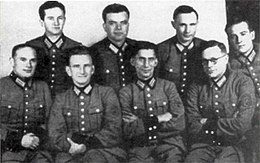Bust of Roman Shukhevych
| Bust of Roman Shukhevych | |
|---|---|
| Canada | |
| For Roman Shukhevych, Schutzmannschaft Battalion 201 | |
| Established | 1973 |
| Location | 53°36′47″N 113°29′26″W / 53.61299°N 113.49064°W |
The bust of Roman Shukhevych in Edmonton, Alberta, Canada is a controversial sculpture located near the Ukrainian Youth Association narodny dim of the Ukrainian nationalist[1][2] and Nazi collaborator[2] Roman Shukhevych, a military leader of the Ukrainian Insurgent Army (UPA), and one of the perpetrators of the Galicia-Volhynia massacres of approximately 100,000 Poles.[3][4]
Description and location
[edit]The bronze[5] bust is located on private property[6] near the Ukrainian Youth Unity Complex in Edmonton.[7] It was partly funded by Canadian taxpayers.[5]
The bust depicts Roman Shukhevych, the Ukrainian ultranationalist and World War II Nazi collaborator.[8] It was erected in 1973 by veterans of the Ukrainian Insurgent Army who emigrated to Canada.[6][9]
Critical reception and vandalism
[edit]
The Russian Embassy to Canada objected to the presence of the bust in October 2018.[5][10]
The Friends of Simon Wiesenthal Center for Holocaust Studies called for the removal of the bust in 2021, stating that the bust and another local sculpture honours "Nazi collaborators and war criminals".[11] Jewish group B'nai Brith also called for the bust's removal.[11]
The bust was vandalised with the word "Nazi scum" in 2019.[8] The sculpture was again dubbed with graffiti in 2021 with the words "Actual Nazi" written in red paint.[7] In reaction to the second vandalism, the Ukrainian Youth Association issued as statement, calling the accusations that Ukrainian nationalist fighters during the Second World War were Nazis "fake news" and "Communist propaganda".[12]
In October 2022, journalist and activist Duncan Kinney was charged with graffiti related to vandalism.[7]
See also
[edit]References
[edit]- ^ Anton Shekhovtsov (2011). "The Creeping Resurgence of the Ukrainian Radical Right? The Case of the Freedom Party" Europe-Asia Studies 63:2, pp. 203–228. doi:10.1080/09668136.2011.547696. "Although originally the UVO was seen as both a military and a political organisation, its military actions were mostly terrorist, while its political activities failed altogether."
- ^ a b Piotrowski, Tadeusz (2007-01-09). Poland's Holocaust: Ethnic Strife, Collaboration with Occupying Forces and Genocide in the Second Republic, 1918-1947. McFarland. ISBN 978-0-7864-2913-4.
...on the German side and Roman Shukhevych ('Tur', 'Taras Chuprynka') as head of the Ukrainian staff, wore the uniform of the Wehrmacht.
- ^ Rudling, Anders (2016). "The Cult of Roman Shukhevych in Ukraine: Myth Making with Complications" (PDF). Fascism: Journal of Comparative Fascist Studies. 5 (1): 26–65. doi:10.1163/22116257-00501003.
- ^ McBride, Jared (Fall 2016). "Peasants into Perpetrators: The OUN-UPA and the Ethnic Cleansing of Volhynia, 1943–1944". Slavic Review. 75 (3): 630–654. doi:10.5612/slavicreview.75.3.0630. S2CID 165089612.
The OUN-UPA-planned ethnic cleansing continued unabated throughout summer 1943. The crescendo came on the night of July 11–12, 1943 when the UPA planned a highly coordinated attack (known among Poles as the 'Peter and Paul action' for the holiday on which it occurred) against Polish villages in three raions: Kovel', Khorokhiv, and Volodymyr-Volyns'kyi. Over one hundred localities were targeted in this action, and some 4,000 Poles were murdered. Finally, the last wave of attacks came in December 1943 before Shukhevych decided to move the cleansing operations to Galicia where tens of thousands more Galician Poles were murdered. Following the killings in Volhynia, the UPA-North group gave the order to 'destroy all traces of the Poles' by 'destroying all Polish churches and all other Polish places of worship'
. - ^ a b c "Canadian monument to controversial Ukrainian national hero ignites debate". RCI | English. 2018-08-13. Retrieved 2022-11-20.
- ^ a b "Group resumes decades-old fight to remove statue of Ukrainian Nazi collaborator outside Edmonton cultural centre". edmontonjournal. Retrieved 2022-11-20.
- ^ a b c "Alberta journalist charged with mischief in vandalism of controversial statue". CBC. 25 Oct 2022.
- ^ a b Noakes, Taylor (7 Nov 2022). "Canada Has a Nazi Monument Problem". jacobin.com. Retrieved 2022-11-20.
- ^ "Ukrainian monuments vandalized, group calls for their removal over historical record". Edmonton. 2021-08-13. Retrieved 2022-11-20.
- ^ Cecco, Leyland (2020-07-17). "Canada police investigate vandalism of monument to Nazi troops as hate crime". the Guardian. Retrieved 2022-11-20.
- ^ a b Lung, Raylene (12 Aug 2021). "Jewish groups call for removal of vandalized Ukrainian WWII memorial". CBC.
- ^ Levytsky, Marco (2021-08-18). "More Ukrainian monuments desecrated in Edmonton". New Pathway Ukrainian News | Новий Шлях Українські Вісті. Retrieved 2022-12-21.
- Busts in Canada
- Sculptures of men in Canada
- Monuments and memorials in Alberta
- Members of the Galicia Division
- 1973 sculptures
- Organization of Ukrainian Nationalists
- World War II memorials in Canada
- 2022 controversies
- Outdoor sculptures in Canada
- Ukrainian-Canadian culture in Alberta
- Vandalized works of art in Canada
- Foreign volunteer units of the Waffen-SS
